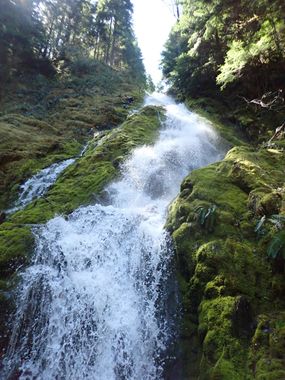Covell Creek (Main Fork)
| Rating: | |||||||||||||||||||||||||||||||
|---|---|---|---|---|---|---|---|---|---|---|---|---|---|---|---|---|---|---|---|---|---|---|---|---|---|---|---|---|---|---|---|
| | Raps:5-9, max ↨110ft
Red Tape:No permit required Shuttle:None Vehicle:Passenger | ||||||||||||||||||||||||||||||
| Start: | |||||||||||||||||||||||||||||||
| Parking: | |||||||||||||||||||||||||||||||
| Condition Reports: | 2 May 2021
"Possible first descent of the main fork on Covell Creek as no anchors or signs of previous passage were found. Access is excellent and this opens mor |
||||||||||||||||||||||||||||||
| Best season: | Dec-May
|
||||||||||||||||||||||||||||||
| Regions: | |||||||||||||||||||||||||||||||
Introduction[edit]
Covell Creek provides ample fun for the canyoneer looking for canyoning opportunities in the Randle area. Covell is a great option when other nearby canyons are running high. With an easy approach and exit, the canyon features some big waterfalls and is fairly open with a short narrows that adds to the appeal. Flows reduce dramatically in the summer months, but the creek's low elevation and easy access make it a great option in the fall, winter, and spring.
Covell offers two main options... and an experienced team could run both of them in a single day.
- West Fork Covell Creek
- Main Fork of Covell Creek -- this page describes a descent of the main fork.
Note that both forks converge below Angel Falls at about 2000ft elevation where a trail crosses. We'll call this spot "the confluence." It's a good place to check the flow on both creeks.
Be aware: this area is quite popular with hikers. Use caution when deploying your rope on some rappels.
- Watershed: 1.16mi^2. Highest point in the watershed is about 5200ft.
Approach[edit]
Covell Creek is located just south of the Cispus Environmental Learning Center. Park at the location indicated and follow the trail to Angel Falls. Several other side trails fork off of the main trail so be aware of this on the approach. Just before reaching Angel Falls, the trail crosses the main fork of Covell Creek which is the checkpoint for the flow. Cross the main fork, then the west fork, then continue on up the Burley Mountain trail. After several switchbacks, the trail starts to return to the creek. At about: 46.42314, -121.85395 at ~2500ft elevation there's an easy place to drop West Fork.
Cross the West Fork and climb out the far side. The forest is open and the going is so easy it can barely be called bushwhacking. Head up the ridge a couple hundred feet until terrain abruptly flattens out around 2600' elevation. Continue southeast for about five minutes and descend easy slopes to drop into the western fork of the Main Branch somewhere between 2500-2600' elevation. Suit up and head downstream.
Descent[edit]
DCL = Down Canyon Left, DCR = Down Canyon Right
Main Fork:
The lack of major vegetation along the sides of the watercourse indicates this creek can rip from time to time.
- R1: 50ft from tree DCL. This is a short drop (and least interesting on the creek); most of the rope is needed for the horizontal distance. At the bottom the central main branch enters and the amount of water increases.
- R2: 30ft.
- R3: 65ft.
- R4: 120ft from tree DCL. There is an awkward move needed to reach the anchor. In high flow, it may be better to rappel out of the water from a tree DCR.
- Bypass a short falls choked with fallen logs DCR.
- R5: Bridal Veil Falls. Not a big drop but very photogenic. Falls is 30ft high, but 80ft of rope is needed from a fallen tree across the creek some distance back from the top.
Below R5, walk downstream to the confluence. The flow doubles (or more) as the west fork of Covell Creek enters DCL. (Below this point the beta is the same as the West Fork.)
Below the Confluence: (BC)
Continue downstream with 1-2 downclimbs until you reach BC-R1. If flow is too high, climb back up to the main trail and exit.
- BC-R1: 75' from fallen log DCR into a nice narrows.
- BC-R2: 75' from a tree DCL. This is Covell Creek Falls and is a great spot for photos. Signs around the watercourse request hikers to remain on the trail to avoid trampling the fragile plant life below the falls. Try to remain in the creek bed to access photo spots, and/or if continuing downstream.
Two established trails connect and travel under the falls. Exit canyon right to return to your cars on trail. At the immediate junction, head downhill, then bushwhack a short bit to the road. Hike up the road a short ways to your cars. Alternatively, a longer, more scenic exit takes the right fork at that junction, and wraps around a nice cliff band. This will take you directly to your cars.
Below Covell Creek Falls is a high tourist area as there's a trail just above the creek DCR. Leaving fixed anchors is not recommended.
- BC-R3: 20ft just below Covell Creek Falls. Anchor off a fallen log spanning the creek.
- BC-R4: 20ft drop a short distance downstream. Anchor off a fallen log spanning the creek.
There are a few more short drops further downstream, but they may not be worth your time. It's an easy exit up DCR to the trail.
Exit[edit]
Exit immediately up DCR to the well-maintained trail just above the creek. Head downstream following the trail until it crosses the creek at the bottom of the hill. Instead of crossing the creek, cut right through the brush and follow pink flagging tape to get back to the road. Walk back to the parking area.
Red tape[edit]
None.
Beta sites[edit]
Trip reports and media[edit]
Background[edit]
First descent of the main fork Covell was in May 2021 by Kevin Clark, Lisa Ripps, Wim Aarts, and Ashley Driscoll.
